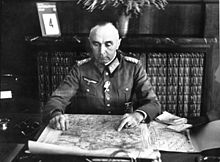Operation Southeast Croatia
Both operations also involved Croatian Home Guard and Italian troops and are associated with what is known as the Second Enemy Offensive (Serbo-Croatian Latin: Druga neprijateljska ofenziva) in post-war Yugoslav historiography.
Although the Partisans and Chetniks had already irrevocably split in the German-occupied territory of Serbia following Operation Uzice in late 1941, this had not yet happened in eastern Bosnia, and in some areas they were still cooperating.
While there were 20,000 Chetnik insurgents located within the area of operations, they offered no resistance to the German–NDH forces and many withdrew east across the Drina river to avoid being engaged.
On 6 April 1941 the Axis powers invaded Yugoslavia from multiple directions, rapidly overwhelming the under-prepared Royal Yugoslav Army which capitulated 11 days later.
[3] At the end of 1941, there were six Partisan detachments in eastern Bosnia, with about 7,300 fighters operating in the Majevica, Ozren, Birač, Romanija, Zvijezda and Kalinovik areas.
[4] According to Enver Redžić, in early January 1942, the Chetniks controlled a large portion of eastern Bosnia, including the towns of Zvornik, Višegrad, Vlasenica, Srebrenica, Drinjača, Bratunac, Foča, Ustikolina, Goražde and Čajniče.
Due to continuing cooperation between the two groups, the Chetniks also shared control of the towns of Rogatica, Olovo and Han Pijesak with the Partisans.
Bader believed that the Partisans and Chetniks were using the area as winter quarters, and that their presence there was a threat to major transport routes through eastern Bosnia.
[7] The operation itself was led by the German 342nd Infantry Division, which had been relieved of its occupation duties in the occupied territory of Serbia by Bulgarian troops.
[9] The offensive targeted areas held by the Romanija, Zvijezda, Birač, and Ozren Partisan detachments, between Sarajevo, Tuzla, Zvornik and Višegrad.
Any captured Partisans were to be briefly interrogated and summarily shot, as were any other insurgents that had attacked the Germans, been caught carrying ammunition or messages, or who resisted or fled.
[13] In the first days of the operation, the 697th Regiment of the 342nd Infantry Division, supported by the Croatian 3rd Home Guard Regiment and four batteries of artillery, thrust out of their bridgehead over the Drina at Zvornik and cleared the high ground southwest and south of that town, and south along the Drina valley road, hindered by roadblocks and destroyed bridges.
In the area of Milići, they captured about 400 insurgents, mostly Chetniks loyal to Jezdimir Dangić, along with a tank, two machine guns, about 160 rifles and a large amount of ammunition.
[16] It had been planned that the Italian 3rd Mountain Infantry Division Ravenna would provide a cordon to the south, blocking any southerly withdrawal by the insurgents.
[16][19] The Romanija Detachment made up forty percent of all Partisans in eastern Bosnia and bore the brunt of most of the fighting during the operation.
[16] On 21 January, Bader dramatically altered his previous orders regarding the treatment of those encountered in the area of operations, directing that those who did not resist and surrendered or merely had weapons in their houses, were to be treated as prisoners of war.
[17] The 1st Proletarian Brigade, less two battalions that were accompanying the Supreme Headquarters, crossed the Igman mountain plateau near Sarajevo with temperatures reaching −32 °C (−26 °F).
The German and NDH forces were successful in recapturing Sokolac, Rogatica, Bratunac, Srebrenica, Vlasenica, Han Pijesak, Olovo, Bosansko Petrovo Selo, and some smaller settlements,[10] and inflicted significant losses on the Partisans.
[23] Because the Chetniks failed to assist the Partisans in the battle, the Central Committee of the Communist Party ceased all further attempts to cooperate with them and issued a declaration on 22 January to "Bosnians!
[10] Faced with overly ambitious objectives and atrocious weather,[24] the combined operation failed to destroy the Partisan forces and was called off on 23 January 1942,[9] with the Germans having suffered casualties of 25 dead, 131 wounded, and one missing,[25] as well as around 300 cases of frostbite.
[9] The Germans advanced north and west from Kladanj towards a cordon established by ten Croatian Home Guard battalions supported by their own artillery.
The Germans also believed that some Partisans merely withdrew into the mountains, concealing their numbers by walking in each other's footprints in the snow, in order to return to the valleys when the Axis forces left.
[19] Operations Southeast Croatia and Ozren were early opportunities for the Germans to learn lessons about the challenges their poorly equipped and often substandard occupation troops faced fighting in the difficult terrain and weather conditions of Bosnia.
